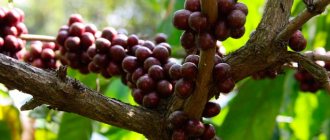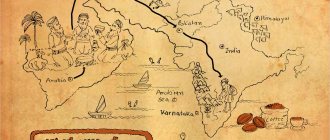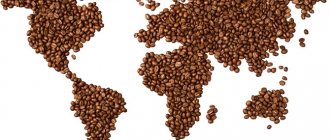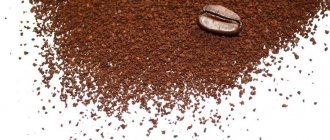When choosing coffee, consumers rarely focus on the place where the beans grow, but the taste and aroma properties of the drink, as well as its quality, depend on this indicator. Coffee raw materials are grown in 50 countries around the world, and about half are exported. Coffee producers do not always cultivate their beans, so the packaging also contains information about where they grow. Let's consider the rating of manufacturers of different types of drinks, both Russian and foreign.
World production volumes by region
The largest suppliers of coffee in the world are concentrated in South America - Brazil, Colombia, Peru, and Venezuela.
The total harvest volumes of these countries account for more than half of the world's harvest. According to the International Coffee Organization (ICO), 4,932,120 tons of coffee beans were harvested in South America last year.
Asia and Oceania is the second most important coffee region. Local leadership is firmly entrenched in Vietnam, followed by Indonesia. Over the past year, the harvest weight was 1,897,880 tons according to official statistics.
The turnover of Australia is taken into account separately - coffee is grown there primarily for its own market.
The climate suitable for growing coffee is tropical. Temperatures below +12C are critical for the harvest.
Mexico and Central America concentrate on growing primarily Arabica beans. The leaders among local coffee producers are Honduras (approximately 5% of global demand) and Mexico (3%). WITH
According to the ICO organization, turnover in this region over the past year amounted to 1,283,760 tons.
In most countries in central Africa, coffee cultivation is the main source of budget income. Work on plantations is the main source of employment for the local population.
According to the International Coffee Organization, over the past year, a crop weighing 1,119,900 tons was harvested in African countries.
World coffee production for marketing year 2019/20
Global coffee production for the 2019/20 marketing year (MY) is forecast to be 5.3 million bags (60 kg) lower than the previous year, falling to 169.3 million, mainly due to the fact that Brazilian Arabica trees enter the off-year period of their two-year production cycle.
Table 1. World coffee production
World coffee production, according to USDA Global
exports are expected to decline by 4.7 million bags to 115.4 million, mainly due to lower supplies from Brazil and Honduras.
With global consumption forecast at a record 166.4 million bags, ending stocks are expected to fall by 400,000 bags to 35.0 million.
Coffee prices, as measured by the International Coffee Organization's (ICO) monthly composite price index, fell to $0.93 per pound in May 2021, the lowest level since September 2006. But by November 2021, they recovered by 15 percent to $1.07 per pound due to reduced supplies.
map of coffee producers and importers
in Brazil is forecast to fall by 8.3 million bags to 39.9 million compared to the previous season, as most trees are in the off-year period of the two-year production cycle. Good weather conditions generally prevailed in most coffee-growing regions during the flowering and fruiting stages.
The robusta crop is forecast to continue to grow, reaching a record 18.1 million bags, up 1.5 million. Good rainfall supported fruit development in the main producing state of Espirito Santo, while good crop management practices contributed to the steady growth of the state of Rondonia.
The combined Arabica and Robusta harvest is forecast to increase from 6.8 million bags to 58.0 million.
Vietnam's production is forecast to reach a record 32.2 million bags, up 1.8 million from the previous year, as acreage continues to expand as well as favorable weather boosting yields.
Due to the fall in black pepper prices over the past 3 years, farmers are no longer replacing coffee trees with pepper. However, some farmers have started planting durian, mango, avocado and passion fruit trees in their coffee gardens.
6 Statistical Facts About World Coffee Production
- Every second coffee bean is grown in Brazil. Almost half of the world's turnover (3,775,500 tons) is cultivated in this country.
- More Arabica beans are grown than Robusta beans - 5,995,449 and 4,216,860 tons respectively.
- The countries of South America not only lead in coffee export volumes, but also increase their hegemony. Over the past year, the harvest of countries in this region increased by 13.9% (+ 603,000 tons).
- The countries of Central America and parts of North America have lost 1.5% of global turnover over the past year.
- Every year, coffee production in the world increases. Now the balance is +7.9% - 721,200 tons of growth per year.
- The Scandinavians are the world leaders in coffee consumption. Finland takes first place with an average of almost 12 kg of coffee per person per year. The second and third places are occupied by Norway and Iceland - 10 and 9 kg of coffee per person per year, respectively.
Top 10 leading countries in coffee production
The largest coffee producing countries grow different varieties and export them to other countries. From there they are sold as soluble and insoluble packaged drinks. Who is leading in this area?
Countries producing the most coffee
Brazil
The undoubted leader in growing different varieties. In addition, Brazil produces its own national drink. The coffee bean harvest level is over 12 million bales. The country produces 1/3 of the world's total grain volume. Main varieties: Serrato, Bourbon Santos, Bahia.
Colombia
Every year the state produces about 10.5 million finished products. In the area of two ports in the Atlantic and Pacific regions, the country has very high soil moisture and optimal climatic conditions. Therefore, this type of invigorating drink turns out to be soft and aromatic. This is exactly what the brewed drink tastes like. Famous varieties are Supremo Medellin, Bogota, Excelso.
Indonesia
It ranks second in terms of the number of coffee beans grown. In total, the number of bales last year was 6.7 million. From the 17th century until now, Indonesia has been considered a successful plantation industry. Various varieties of Java coffee are grown on the islands and in the Indonesian archipelago. The following varieties grow in the country: Sumatra, Sulawesi, Java.
Vietnam
The number of grains ready for delivery amounted to 5.8 million bales. The first varieties of the drink appeared in Vietnam back in the 1860s. Then local farmers decided to start cultivating grains themselves. Over the course of several years, productivity increased sharply, which led to reason to think about the low quality of plants. The main variety grown is Robusta.
Provinces of Vietnam where coffee is grown
Read on our website: varieties of coffee from Vietnam.
Mexico
There are about 100 thousand black coffee producers in the south. The drink was first brought to the state at the end of the 10th century. Mexico ranks second in grain exports abroad. Types of varieties grown: Altura, Pluma, Liquidambar MS.
Ethiopia
The annual coffee production in Ethiopia is 3.8 million bales. In addition to production, active exports to other countries are carried out. For the first time, raw materials for the drink began to be grown in the city of Kaffa, hence the name of the plant. Types of cultivated varieties: Sidamo, Harar.
Coffee growing regions in Ethiopia and planting types
India
The state took sixth place in the ranking position. According to the production results for the past year, about 3.8 million bales were counted. After the first variety of grains was grown, it was transported for cultivation on the farms of Eastern Arabia. To this day, the authorities control the quality of plant varieties and their fruiting. Main types of coffee: Malabar Monsooned, Mysore.
Guatemala
The highest grades of coffee are grown on volcanic slopes. These are ideal conditions for the growth of grains enriched with incredible taste and aroma. The first people responsible for cultivation in the region were German emigrants. Today, about 3.5 million bales are harvested from plantations. Cultivated varieties: Huetenango, Atitlan.
Ivory Coast
Today the country of origin occupies the penultimate place in the ranking. The harvest amounted to 3.3 million bales, which is significantly less than in the 90s. Due to enormous competition, the quantity of exports began to decline, which affected the quality of raw materials. Now farmers grow only the Robusta variety.
Uganda
The country annually harvests 3 million bales of coffee. This is the only industry in the state. Uganda specializes mainly in growing the Robusta variety, but in some areas there are Arabica plantations.
Watch the video: The difference between Robusta and Arabica.
Coffee producing countries make good profits by supplying various types of coffee.
Indonesia
The fourth country in production, sometimes pushes Colombia out of third, its main figure is 10-11 million bags . It was to the islands of the Indonesian archipelago that the Dutch brought coffee tree seedlings stolen in Yemen. This marked the beginning of the spread of coffee production to other countries of the world.
However, the imported Arabica trees soon died, and the planters switched to the less demanding Robusta. It now makes up 90% of Indonesian coffee. The majority of plantations are concentrated in Sumatra and Java. The most famous and most expensive coffee in the world is Kopi Luwak, produced in Indonesia.
Rating of producing countries
Most companies that offer coffee beans are roasters and packers. Manufacturers from those countries where the product is grown are especially valued.
Rating of coffee bean producing countries:
- Most coffee trees are grown in Brazil. Some consider its taste too simple, others love it for the presence of notes of cocoa, the absence of bitterness and impurities. Arabica and Robusta are grown in Brazil. Very often, when roasting, Brazilians add cinnamon or cloves. This is done in order to remove the specific smell (they have varieties grown on iodine soils) and deepen the taste.
- Guatemala specializes in the sale of green coffee, which is grown without the use of chemicals. The taste depends on the region where it is grown. Almost all coffee grown in this area has a subtle hint of smoke and characteristic hints of various spices. The most common Arabica variety is Typica.
- Ethiopia is the country where coffee first appeared. Mostly wild Arabica beans are harvested here. Approximately 40% of the harvest comes from man-made plantations. Coffee beans are cleaned using dry processing. The drink has a sour taste and a berry aftertaste. The best coffee beans are wet processed.
- Coffee production in Kenya is strictly controlled by the government. The most delicious drink is obtained from grains grown on the slopes of Meru and Kilimanjaro. It has a slight sour fruity taste.
- Colombian coffee varieties are highly valued throughout the world. Almost all plantations are located in high mountain areas, which has a beneficial effect on the quality of the product. For beans grown in the country, the name “Colombian coffee” is used; this trademark was registered in 2007. Thanks to the unique climate, special growing traditions, collection and processing of beans, the drink has an expressive aroma. In Colombia, only Arabica is grown.
Many well-known brands of bean coffee are grown in the Caribbean, in Yemen (the drink has fruity notes), in India (the taste of the coffee is mild but tart), in Cuba. Which one is better is difficult to answer, since connoisseurs choose according to personal taste preferences.
Rating of bean coffee producers
As of 2012, the ranking of coffee producers was as follows:
- Brazil – more than 2.5 billion kg;
- Vietnam – 900 million kg;
- Colombia – 696 million kg;
- Indonesia – 411 million kg;
- Ethiopia – 390 million kg;
- India – 300 million kg;
- Mexico – 270 million kg;
- Guatemala – 240 million kg;
- Peru – 210 million kg;
- Honduras – 162 million kg.
In our store you can purchase coffee capsules made from high-quality coffee beans.
Which countries are among the top ten largest coffee exporters?
Brazil is the world's leading coffee producer and exporter, and Colombia, Honduras, Peru and Mexico are also among the top ten coffee producers.
Table 2. World coffee exports
World Coffee Exports, According to USDA
Five Latin American countries are among the top ten largest coffee exporters. Whereas the coffee area harvested has remained relatively constant in Brazil over the past two decades, in Colombia and Mexico it declined by 6.0% and 9.8%, respectively.
In contrast, Honduras and Peru have more than doubled the area under coffee cultivation. These production changes in the region have shifted countries towards export markets.
Brazil has increased its export market share from 23% to 29% over the past two decades, while Colombia has lost 8 percentage points, rising from 17% to 9%.
Mexico accounted for 5% of global coffee exports two decades ago, but has now lost its status as a net exporter. Guatemala remains one of the largest coffee exporters with a 3% market share (2 percentage points less than two decades ago).
Costa Rica is no longer a major exporter, while Honduras and Peru have export market shares of 4% and 3% respectively.
coffee exporting countries
Latin American countries will continue to play an important role in global coffee markets, despite the growing presence of Asian suppliers.
The region's favorable production potential is supported by growing consumption in emerging markets such as China, the Russian Federation and Korea, as well as exporting countries such as India, Indonesia and Vietnam.
However, to maintain market share, coffee producers in Latin America will have to deal with changing climatic conditions that will make some regions unsuitable for coffee production and encourage the spread of pests and diseases such as Coffee Leaf Rust.
World import of coffee beans
EU imports are forecast to fall by 1.1 million bags to 48.0 million and account for more than 40 percent of global coffee bean imports. The largest suppliers are Brazil (29%), Vietnam (25%), Honduras (8%) and Colombia (6%). Ending inventories are expected to decrease by 400,000 bags to 14.0 million.
Table 3. World coffee imports
World coffee imports, according to USDA The
United States imports the second largest amount of coffee beans, and is projected to decline by 1.0 million bags to 26.2 million. The largest suppliers are Brazil (24%), Colombia (22%), Vietnam ( 15%) and Guatemala (6%). Ending stocks are forecast to fall by 500,000 bags to 6.9 million, but consumption is little changed after rising last year.
For nearly 70 years, the National Coffee Association of USA has conducted National Coffee Data Trends (NCDT), which tracks consumer behavior and perceptions that shape coffee trends in the United States. Introducing the infographic for the trend for 2021:
NCA infographic
Consumer representatives
All Japan Coffee Association (AJCA - All Japan Coffee Association),
Coffee Association of Canada (CAC- Coffee Association of Canada),
European Coffee Federation (ECF-European Coffee Federation),
Institute for Scientific Information on Coffee (ISIC- Institute for Scientific Information on Coffee),
National Coffee Association of the USA (NCA-National Coffee Association of USA),
Russian Association of Tea and Coffee Producers (Roschaykofe),
American Specialty Coffee Association (SCAA-Specialty Coffee Association of America),
European Specialty Coffee Association (SCAE - Specialty Coffee Association of Europe)
US Coffee Industry Key Indicators:
- The total economic impact of the coffee industry in the United States in 2015 was $225.2 billion.
- Coffee-related economic activity represents approximately 1.6% of the total U.S. gross domestic product. Consumers spent $74.2 billion on coffee in 2015
- The coffee industry accounts for 1,694,710 jobs in the US economy.
- The coffee industry generates nearly $28 billion in taxes (including ancillary products)
- In terms of household coffee consumption in this country, coffee ranks first in terms of consumption compared to other beverages with 43%.











